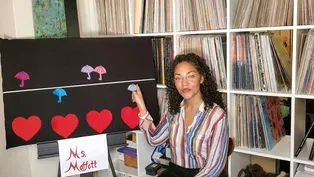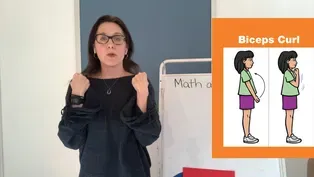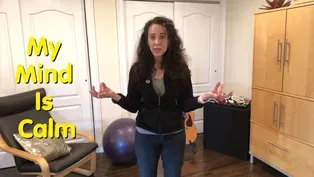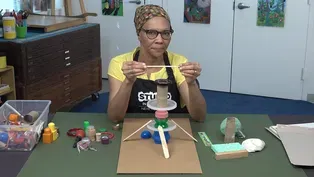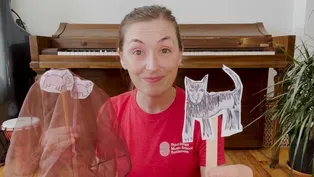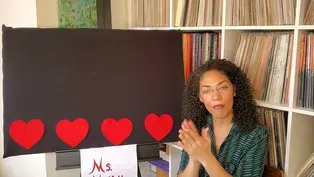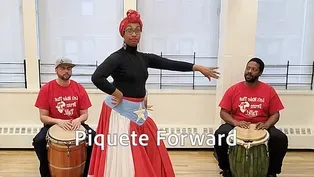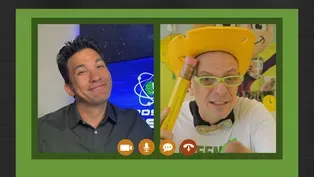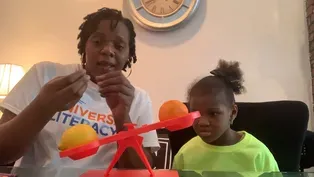
What Sounds Do You Hear in Jog?
2/5/2021 | 57m 5sVideo has Closed Captions
Learn about the core unit in patterns and human-made resources, read RUBY’S BIRDS.
Learn about the core unit in patterns and human-made resources, read RUBY’S BIRDS, blend sounds and practice short o, w, j, y, and v. LET’S LEARN helps children ages 3-8 with at-home learning. One-hour programs feature instruction by educators and virtual field trips.
Problems with Closed Captions? Closed Captioning Feedback
Problems with Closed Captions? Closed Captioning Feedback
Let's Learn is a local public television program presented by THIRTEEN PBS

What Sounds Do You Hear in Jog?
2/5/2021 | 57m 5sVideo has Closed Captions
Learn about the core unit in patterns and human-made resources, read RUBY’S BIRDS, blend sounds and practice short o, w, j, y, and v. LET’S LEARN helps children ages 3-8 with at-home learning. One-hour programs feature instruction by educators and virtual field trips.
Problems with Closed Captions? Closed Captioning Feedback
How to Watch Let's Learn
Let's Learn is available to stream on pbs.org and the free PBS App, available on iPhone, Apple TV, Android TV, Android smartphones, Amazon Fire TV, Amazon Fire Tablet, Roku, Samsung Smart TV, and Vizio.
Providing Support for PBS.org
Learn Moreabout PBS online sponsorshipMore from This Collection
Video has Closed Captions
Read SCHOOL BUS and draw one, learn about prefixes and pitch, build sculptures. (57m 48s)
Running and Counting Both End in “ing”!
Video has Closed Captions
Move to improve, find the missing number, learn songs from Ghana, read ABUELITA’S SECRET. (58m 17s)
What Sound Does “aw” Make in Draw?
Video has Closed Captions
Read a story, discover "au" and "aw," learn about density, count, and move with music. (56m 58s)
Can You Find the Short “u” in Subtract?
Video has Closed Captions
Help Super Grover 2.0 solve a prickly problem, read ALL THE WAYS TO BE SMART. (56m 19s)
What Sound Does “gl” Make in Glove?
Video has Closed Captions
Play the glockenspiel, help Super Grover 2.0 make a cart move, read TWO WOOL GLOVES. (58m 9s)
Incredible Starts with Short “i”!
Video has Closed Captions
Solve problems with Super Grover 2.0, catch a rainbow, hear a piano sound like a cuckoo. (56m 9s)
What’s the Sound of “oo” in Book?
Video has Closed Captions
Explore animals’ form and function, sing about the 3 little pigs, read THE LITTLE BOX. (58m 15s)
We’re Reducing, Reusing and Recycling!
Video has Closed Captions
Learn all about rhythm and the number 9, read A BAG IN THE WIND. (56m 17s)
Video has Closed Captions
Learn to dance bomba and grow food in a city, read WOLF CUB’S SONG. (55m 20s)
How Many Syllables are in Invent?
Video has Closed Captions
Invent your own instrument, make 10 to add numbers to 20, read ONE GOLDEN RULE AT SCHOOL. (57m 36s)
Video has Closed Captions
Learn about the science behind mind reading, count shells, read MY BIG FAMILY. (57m 27s)
Which is Heavier: One Apple or Two Apples?
Video has Closed Captions
Defy gravity, learn secret code words for fast and slow in music, read WHOOO KNEW? (58m 5s)
Providing Support for PBS.org
Learn Moreabout PBS online sponsorship- [Narrator] Ready to learn?
- Hi.
- Hi.
- [Narrator] It's time to share a story, [woman hissing] read and write.
- Let's read it back.
- [Narrator] Discover science, sing.
♪ Some ♪ - [Narrator] Play, and so much more.
- Cupcake.
- Very good.
- [Narrator] Stay tuned for lessons and activities.
- We're gonna start making some words, isn't that fun?
- Mm-hmm.
[upbeat music] - [Narrator] Funding for this program was provided by the JPB Foundation.
[upbeat music] - Hi, I'm Mya Thompson, and I'm here to read to you a book called "Ruby's Birds".
This is a book I wrote, and Claudia Davila illustrated.
So here we go.
School's out.
Mom and dad are at work.
My brother Malek, is at soccer practice.
Grandma's at her spot near the window.
Alex keeps her company.
Things are too quiet around here.
I know what to do, I play the piano; the piece my parents say is very grown-up.
I practice my dance routine; the one Malek calls stumping.
I talk with Alex in the secret language grandma taught us.
I sing at the top of my lungs, the song I made up myself.
My neighbor Eva, from downstairs, hears everything.
She calls up from her window.
"Ruby, wanna go to the park?"
"Yes, yes, yes, yes, yes," I sing.
We pass my favorite bakery.
We pass Cece's apartment.
We walk right past my regular park, the one with the twisty slide and the sprinklers.
I guess Eva's going to a different park.
I skipped to keep up.
I follow her all the way to Central Park, where my parents sometimes take us on Sundays, when we're all dressed up.
Eva's going into the woods.
I've never been that way.
We sing made-up songs about joggers and strollers and fancy dogs.
Suddenly, Eva stops, she looks up, she's listening.
Bee buzz, buzz, buzz.
Bee buzz, buzz, buzz.
I quiet down and I listened too.
"What's wrong?"
I wonder.
I hear a police car, a plane, some barking.
[dogs barking] I took on Eva's sleeve, but she's not paying attention.
She holds her binoculars up to her eyes.
She's frozen like a statue.
And then she smiles.
A huge smile.
I guess everything's okay.
So I start singing again.
"Oh, Ruby," Eva sighs, "You scared him away."
"Who did I scare away?"
I ask.
Eva flaps down on a bench.
I sit too.
"It's a bird I've only ever seen back home in Costa Rica," she says.
He's just stopping through on his way North, because this is the best patch of woods for miles around.
He's quite a singer, just like you.
If you stay quiet, we may be able to find him again.
"He's a golden-winged warbler," I nod.
I don't say a word or sing a word either.
It sounds like something from a fairy tale.
We move carefully.
We are serious.
We pay attention.
We watch for tiny movements in the leaves.
We try and try.
"No luck today," says Eva.
But now you know what to do.
I sing myself to sleep as usual.
On Sunday morning, I beg for a walk to Central Park.
Malek's not interested, but it's family time.
So he has to come anyway.
We pass the bodega.
We pass the theater.
I sing my song.
My family listens along.
At the park, I lead them straight into the woods.
I'm silent.
I'm serious.
I'm paying attention.
I hear a rustle in the leaves.
"Shh," I say.
Just like Eva, I'm frozen like a statue.
A tiny bird pops out of the leaves.
It looks one way, then the other, then right at me.
I can't help it.
I get that huge smile, just like Eva's.
"Look," I yell.
"I, yes," says grandma.
"I saw, a warbler."
I sing, as he flies away.
So that's our story.
And I wanna tell you a little bit more about this story before we're done.
As a brand-new birdwatcher, Ruby is lucky to live near Central Park, one of the best places in the world to enjoy birds.
You can find more than 280 kinds of birds there, if you know where to look and how to listen.
It's mind-boggling to think that so many bird species live right in the center of New York City, one of the busiest cities in the whole world.
Some birds like robins, starlings, and crows stick around all year.
Others, like the warblers, use the park mostly as a stopover in spring to rest and eat, before they their migration North to nest and raise their own family.
[birds singing] Warblers are a group of small songbirds famous for their high-pitch warble.
Eva has a feeling that Ruby will love getting to know a bird that likes to sing as much as she does.
When Eva hears the "Bee Buzz, Buzz, Buzz" song of a male golden wing warbler in Central Park's North Woods, it reminds her of the comforting forest sounds back home in Costa Rica, where this bird spends the winter.
She grew up calling warblers rain eaters or little queens, and gets a burst of joy every time she finds one.
She also knows that these warblers are becoming rare and rare in the wild.
So she is grateful to see that this one has safely made its journey from Central America.
So that's all about Ruby's birds, but there's one more thing to know.
You can find 14 different species of birds in the pages of this book, if you go back through and look carefully.
There is a Cal bird, there is a night heron.
There is a mallard.
There is a crow.
There is a falcon, an oriole, a dove, a pigeon, a finch, a starling, a robin, a waxwing, a sparrow, and of course, the golden-wing warbler.
So you can go back and look and find all of these birds, not only here in the pages of this book, but these are common birds in most cities around the United States.
So you can probably find them in your neighborhood too.
Have fun and listen, and watch, you can find birds just like Ruby.
Bye-bye for now.
- Hi, movers and shakers.
This is Violet.
And today we have some special guests.
My cousins, Liam and Aiden are gonna help us sing a song called "Rattlin' Bog".
They're gonna sing the call, and I'm gonna sing the response.
That means they're gonna say something, and I'm gonna repeat after them.
Can you help us sing this song together?
Great.
All right.
♪ Ho, ro, the rattlin' bog ♪ ♪ The bog down in the valley o ♪ ♪ Ho, ro, the rattlin' bog ♪ ♪ The bog down in the valley o ♪ Well, in the bog.
- Well, in the bog.
- There was a tree.
- There was a tree.
- A rare tree.
- A rare tree.
- Oh, rattling tree.
- Oh, rattling tree.
♪ And the tree in the bog, and the bog down in the valley o ♪ ♪ Ho, ro, the rattlin' bog ♪ ♪ The bog down in the valley o ♪ ♪ Ho, ro, the rattlin' bog ♪ ♪ The bog down in the valley o ♪ And on that tree.
- And on that tree.
- There was a branch.
- There was a branch.
- A rare branch.
- A rare branch.
- Oh, rattling branch.
- Oh, rattling branch.
♪ And the branch in the tree, and the tree in the bog ♪ ♪ And the bog down in the valley o ♪ ♪ Ho, ro, the rattlin' bog ♪ ♪ The bog down in the valley o ♪ ♪ Ho, ro, the rattlin' bog ♪ ♪ The bog down in the valley o ♪ - That was so much fun.
Thanks, Liam and Aiden.
Thanks, everyone.
[upbeat music] - Hi, scholars, my name is Trinette, and I'm so excited to be working with you all today.
For this lesson, we will be working with three different activities.
Let's review them.
For activity number one, we will blend phonemes to say words.
For number two, we will isolate initial and final phonemes in words.
And for the last activity, which is number three, we will blend, decode and build words.
So let's begin with the first activity.
It says here that we will blend.
But what does it mean to blend?
When we blend, we simply are taking the individual sounds that we hear, and we're putting them together to say, or build a word.
So for example, listen to these sounds that I'm about to say, M, I.
If I blend them together, it forms the word, my.
Let me do another example for you.
I want you to listen to the individual sounds that I say, P, E, G, blend them together.
What do I hear?
Peg.
I think you got the gist of this activity.
So what you're going to do, at home scholars, is you're going to listen to the individual sounds that I say, and you're going to blend them together.
What are you gonna do?
Blend them together.
So here is the first example.
Listen closely.
H, A, T. Blend them, what do you get?
Hat, excellent.
Here's the next example.
P, A, C. Blend those sounds together.
And you get pack.
A few more.
A, D, let's blend them together.
It forms the word add.
And here's our last one.
B, A, G. Let's blend those sounds together.
What word does it build?
Bag.
Excellent work, learners.
Now we're going to look our activities that we had listed, and we just completed activity number one.
So I'm just gonna put a check mark next to it.
Now for number two, we will isolate initial and final phonemes in words.
Now notice how I have two words with a red box around them, initial and final.
What does that mean?
Well, initial means in the beginning or the beginning sound, and final means end or the ending sound.
So for activity number two, we're gonna listen for sounds that we hear in the beginning of a word, and then we will listen for sounds that we will hear at the end of a word.
Are you ready?
Awesome.
So I'm gonna give you the first example.
The word is time.
Can you repeat after me?
Time.
What is the initial sound that you hear?
T is correct?
Let's do one more together.
Repeat after me.
Cut.
What is the initial sound that you hear?
C is correct?
Now I'm going to give you three more examples.
I will say the word.
You will repeat it.
And then you gonna tell me the initial sound that you hear.
Sack.
What's the initial sound?
S. Next word, deep.
What is the initial sound that you hear in the word, deep?
Did you say D?
Awesome job, learners.
D is the initial sound?
Here is our last example.
Pit.
I'll say it again.
Pit, what is the initial sound that you hear in the word, pit?
Did you say P?
You are correct.
Now, let's switch it up a bit.
Remember we were working with the initial and final sounds.
So now I'm going to say some words, and I want you to tell me the final sound or the last sound that you hear at the end of the word.
So for example, if I said the word, name.
Again, if I said the word, name.
What is the last sound that you hear?
M, exactly.
Remember the last sound is also the final sound.
So we're gonna have three words that we will work with.
I will say it.
You will repeat it, and then tell me the final sound.
He has the first one.
Hit.
I'll say it again.
Hit.
What is the final sound that you hear in the word, hit?
T is correct.
Next one, seal.
Seal.
What is the final sound that you hear in that word?
Great.
L is correct.
Last one.
Harp.
Harp, what is the final sound or last sound that you hear in the word, harp?
P is correct.
Scholars, we just completed activity number two, which was isolating initial and final sounds.
So I'm just going to put a check mark there.
Now we're moving on to activity number three, in which we will blend the code and build words.
So for the first part, I will say a word.
You will repeat the word, and then you will tell me the middle sound and name the vowel.
So for example, if I said jug, you will repeat jug.
Then I will say the middle sound is u, and then I will name that middle sound, which is short vowel u.
Now, let's review our vowels.
We have A, E, I, O, and U.
A as in A, E as in E, I as in I, O as in O, U as in U, okay?
So here's the next example.
Repeat after me, with.
What is the middle sound that you hear in the word, with?
Yes, I.
What is the name of the middle sound?
Yes, short I.
Now, you got the gist of it.
So here's a few more.
Repeat after me, jug.
What is the middle sound?
U is correct.
Can you name that middle sound?
That's right.
Short vowel O, or short O.
Here's the next one.
Cup.
Repeat after me.
Cup.
What is the middle sound that you hear in the word, cup?
U is correct.
Can you name that middle sound?
Yes, short U.
Here's the last one.
Repeat after me.
Wag.
What is the middle sound that you hear in the word, wag?
A is correct.
Now, can you name that middle sound?
Yes.
Short A.
Now, we will practice with some letter sound cards.
So there will be a letter on the card, along with a picture, and then I will tell you the sound that it represents.
So repeat after me.
W, walrus, W. Again, W, walrus, W. Here's the next one.
J, jellyfish, J.
One more time.
J, jellyfish, J. V, volcano.
V. One more time, V, volcano, V. That's better.
Y, yak, Y.
One more time.
Y, yak, Y.
And the last one, U, umbrella, U. U, umbrella, U.
Great.
So now that we have our walrus, jellyfish, volcano, yak, and umbrella, we're going to look at some words that have those letters.
So now I'm going to put some letter cards here in my pocket chart.
And I'm gonna separate them a bit.
Watch me as I try to blend the sounds and build a word.
Y, A, K. Y, A, K. Now I'm gonna bring over the next card.
Y, A, K. I will blend them, yak.
What's the word?
Yak.
Here is the next example.
So I'll take these away, and I'm going to put or place another set of letter cards or sound cards.
W, I, G. I'm going to slide this one next to this one.
W, I, W, I, G. Wig.
Can you repeat that?
Wig.
Let's do one more.
J, U.
Make that one a little closer.
J, U.
So I'm gonna bring this one over.
J, U, G. Jug.
Can you say that with me?
Jug.
Great job, learners.
Now that we've completed working with the sound cards, here is another activity that we will complete.
I have a chart here or sheet here that has lines with words on them, and then some sentences.
And I'm gonna move it in a little closer.
Let's look at line number one.
Read the words with me.
Wag, wig, tub, but, jug.
What do you notice about that first line?
Do you notice anything about any of the words that you see?
Yes, the last three words, tub; but, and jug, all had the middle sound of, u, which is short u.
And yes, the first two words, wag and wig, have the same initial sound, which is W. We were able to get through a lot of activities, and I hope that you were able to learn something new today.
Learners, until next time, I'll see you soon.
Bye-bye.
[upbeat music] - My name is Liz and my husband, Dave and I have four beautiful kids.
John and Jordan are both on the autism spectrum.
With autism, you have your set of challenges, but we believe that their brain works in a beautiful way.
Children on the spectrum can become fixated on a particular topic or special interest.
John loves building structures.
Lately, Jordan's passion has been baking.
We like to use their interest to help motivate them.
- Do you wanna bake cupcakes?
- Mm-hmm.
- But we can't bake a cupcake until we do this homework.
John and Jordan both struggle with multi-step directions.
The chart really does help them understand what they need to do next.
The whole process of baking has so many wonderful advantages.
It helps support reading and mathematics.
[indistinct] - [Both] 12.
- [Liz] Leaning into their interests has been a great motivator for the boys.
It's helped them with their self-esteem and their independence, but it's also been a great way for us to bond as a family.
[upbeat music] - Hi, friends, my name is Lily, and I'm so happy to be here with you today.
This morning, I was reflecting.
That means thinking carefully about the time we've spent since I've been at home.
And I realized that at school, we follow a schedule.
We arrive, we have breakfast, we play with toys.
We go to morning meetings.
We have centers, and so on.
And we pretty much follow that schedule every day.
But at home, it's kind of harder to create a schedule.
But then I reflected more.
That means I thought carefully.
And I realized I had started to follow some routine each day.
For example, in the morning, I wake up and stretch.
[yawning] I eat breakfast.
I sing, which of course, means that I do some dancing.
♪ La la la la la, la la la la la, la la la la la ♪ And then I get started with my work, and I do the same morning routine, the next day, and next day, and the day after that.
Do you know what it's called, when the same thing keeps repeating?
It's called a pattern.
Are there any patterns that you follow at home?
Well, I think I should call Omar, because he usually has some fun ideas, and he might have some fun ideas, for some ways we can explore patterns.
But also, even after trying all those new dance moves during my morning dance routine, I still feel kind of lonely.
So it would be really nice to see Omar's face.
Let me give him a call, and see if he answers.
Omar, Omar, Omar.
- Hi, Lily.
- Hi, Omar.
How are you today?
- I'm good.
I'm feeling energized and ready to get started.
How are you today?
- I'm doing okay.
Omar, I was reflecting, that means thinking carefully this morning, about the pattern I follow each morning for my daily morning routine.
Are there any patterns that you follow each day?
- Let me think.
Well, I do do the same thing before bed, every night.
I brush my teeth, write a poem, and read a book.
- Ah, you brush your teeth, right a poem, read a book.
Brush your teeth, right a poem, read a book.
Brush your teeth, right a poem, read a book.
- Lily, that's right.
That's my pattern.
I brush my teeth, I write a poem, and I read a book.
Lily, do you know what a core unit is?
- Is it a dance move?
- Well, not exactly.
A core unit is the smallest part of a pattern.
It's the part of the pattern that keeps repeating.
So the core unit for my bedtime routine is... Well, Lily, what do you think?
What's the part of my bedtime routine that keeps repeating?
- Well, it's what you do every night.
You brush your teeth, write a poem, and read a book.
That's what keeps repeating.
- Exactly, Lily.
I think we're ready.
And I think we're ready for a fun game we can play.
It's called What's The Core Unit?
- Oh, yay!
How do we play, Omar?
- Okay, for this game, we just need materials we can find around the house.
We'll each make a pattern.
Remember, a pattern is something that keeps repeating.
We'll reveal it.
That means show it to each other.
And then we have to guess what the core unit is.
- Omar, you're so creative.
That sounds so fun.
I'm ready to go.
Let me go get my materials.
- Let me go too.
- [sighs] Okay, Omar, I think I made a pattern.
- Okay, let's see it.
- Are you ready to look at my pattern?
- I am so ready, Lily.
- Okay, here we go.
I call this pattern my hair accessory extravaganza.
- [Omar] Oh, Lily, that's such a nice pattern.
I see you used hair clips and bobby pins.
- That's right, Omar.
That's exactly what I used to create this pattern.
Would you like to read it?
- Sure, I see hair clip, bobby pin, hair clip, bobby pin, hair clip, bobby pin, hair clip, bobby pin.
- Great, Omar.
Now what's that word that you taught me?
- Core unit, the smallest part of the pattern that keeps repeating.
- [sighs] That's it.
The core unit.
Well, this is definitely the smallest thing in my pattern.
Is this the core unit?
- Well, the hair clip is the smallest item, but it's not the smallest unit that keeps repeating in the pattern.
So what do you think the core unit is of your pattern?
- The unit that keeps repeating.
Is it this hair clip, bobby pin?
- Yes.
- Is that my core unit?
- Yes.
Your core unit is hair clip, bobby pin.
That's the part that keeps repeating in your pattern.
Good job, Lily.
- Thank you, Omar.
Okay, I'm ready to see your patterns.
- Okay.
Let me go get it.
This pattern is called bottom of the bag.
- Ooh, it's so shiny.
All right.
I'm ready to read that pattern.
- Here we go.
- I see quarter, quarter, penny, penny.
Quarter, quarter, penny, penny.
Quarter, quarter, penny, penny.
- That's right, okay, so Lily, in my pattern, what's the core unit?
- What's the unit that keeps repeating?
I know, quarter, quarter, penny, penny.
- Yes, that's my core unit.
You got it.
- [giggles] Awesome, Omar.
All right.
I call this pattern, things that chart with the letter B, ready?
- [Omar] Yes.
Oh, wow!
I see you used butterflies and bows.
They both start with the letter.
- That's right.
Can you read it, Omar?
- [Omar] Okay, butterfly, bow, bow.
Butterfly, bow, bow.
Butterfly, bow, bow.
- That's right, so what's the core unit that keeps repeating?
- The core unit is butterfly, bow, bow.
That's the part that keeps repeating.
- Exactly, Omar.
All right- - Okay, let me go.
Let me grab one more.
I call this one dining in.
- Ooh.
Oh, another shiny pattern.
Oh, Omar.
I see you used utensils that we eat with.
All right.
Should we read it?
- Let's do it.
- [Lily] Fork, knife, spoon.
Fork, knife, spoon.
Fork, knife, spoon.
- Great job, Lily.
So what do you think the core unit is?
- I definitely think it's fork, knife, spoon.
- That's right, Lily, if I were to extend this pattern, that means keep it going, what would come next?
- Well, a fork, definitely.
- Yeah, that's correct.
But that's only part of what comes next.
Remember a pattern is made of units.
What unit comes next?
- [sighs] The core unit.
You're right, Omar.
What comes next is fork, knife, spoon.
- Great job.
Yes, Lily, you got it.
I think we should celebrate.
I think we should dance.
- Oh, great, Omar.
You know I love to dance.
I have an idea.
Why don't we make dancing patterns with our bodies, and then the other person has to guess what the core unit is.
- That sounds so fun.
Do you wanna start?
- Yes.
- Okay.
Here comes the music.
[upbeat music] - All right, Omar.
That's my core unit.
- Let me think.
Side to side, bounce, bounce.
That's the core unit of your dance!
- You're so right, Omar.
That definitely was my core unit.
Okay.
What's your dance pattern?
- Okay.
Here it comes.
[upbeat music] Okay, Lily.
What do you think my core unit is?
- I noticed you went, wiggle, wiggle, wiggle, wiggle.
Side arm, side arm, side arm, side arm.
- Yes, that's my core unit.
Good job, Lily.
- [sighs] Thank you, Omar.
And thank you so much for playing with me.
Omar, if friends want to play some pattern games at home, how do they play them?
- If you want to play What's The Core Unit at home, just make a pattern with anything you find around the house, and then invite your trusted adult or sister or brother or a cousin you may live with, to find the smallest part, the core unit that keeps repeating.
- Great, Omar, and then friends can also make dancing patterns at home.
Remember, math is all around you.
Go see what maths you can find today.
Bye, Omar.
- Bye, Lily.
Bye, everyone.
- [Lily] Bye!
[upbeat music] [speaking in foreign language] [indistinct] - [Both] 12.
[speaking in foreign language] [upbeat music] - Huh, I wonder what this is.
Well, it's round, and it has walls on the sides.
So you could put something in it, but it has all these holes at the bottom.
So whatever you put in it would definitely fall out.
Oh, hello there, friends.
I was just looking at this object, and I'm not sure what it is, but I do have a little book, that's gonna tell me all about it.
A sieve.
What is a sieve?
Wow, this says this was made 200 years ago by people, and that they used it in their kitchens, and they'd put flour in it, and then sift out the flour and grains.
So only the small stuff could fall through the holes.
You know who would love this?
Ms. Sabrina loves looking at old things.
Let's call Ms. Sabrina right now.
[phone ringing] I hope she's home.
[phone ringing] Oh, hi, Ms. Sabrina, how are you doing today?
Oh, me?
Well, I was just looking at this really old object, and I found out that it's called a sieve, and it was made by people over 200 years ago.
I know, I thought you'd really would be interested in it too.
- Oh, Ms. Heather.
I'm doing well.
Thanks for asking.
I was just about to call.
You know, that sounds like a really interesting object.
You know, humans have been making objects for as nearly as long as we've been living on this planet.
You see, every human community is made up of people who need resources to survive.
Many of the resources that we need to survive, we can find in nature.
Resources like trees, plants, water, and air are all very important resources that humans need.
We need trees, so we can have clean air to breathe.
We need clean water to drink, so our bodies can stay hydrated.
We even need plants, so that we can grow and eat from.
Every day, we need resources that are made by humans.
- Wait, Ms. Sabrina, I think you may be giving us a hint as to what today's lesson might be about.
You said that people need certain resources in order to survive, and that some of these resources come from nature, and then other resources are made by humans.
What could this lesson be about?
Friends, do you know what this lesson might be about?
Wait, do I hear something?
[gasps] Did you say natural resources?
Wait.
I think I heard something else.
[gasps] Resources made by humans.
Huh?
Ms. Sabrina, we think that today's lesson might be about natural resources and human-made resources.
Are we right?
- That's right, today, we're going to be talking about human-made resources, which I went ahead and put on our social studies board.
Let's talk about human-made resources, and natural resources, and how these resources sometimes help communities to meet their needs.
And other times, it's just something we want.
For as long as people have lived, they've needed certain resources to survive.
Let's take a closer look at natural resources versus human-made resources.
Natural resources are resources that come directly from the earth.
Humans cannot make natural resources.
Some examples of natural resources are trees, plants, land, water, rocks and minerals.
I went ahead, and I drew up a park for natural resources.
On my card, I have a tree, rock, plants, and water.
Remember friends, humans cannot make natural resources.
These are resources that come directly from the earth.
[upbeat music] For hundreds of years, people have used resources that they find in nature to make something new.
The new objects made from natural resources are called human-made resources.
Here is another card I drew up.
Human-made resources.
And on this card, I share an example.
Here is a tree and some rocks.
Many a years, we have used natural resources, such as trees and rocks, to create a new object, such as a home.
The new object that we've created is called human-made resource.
[upbeat music] We're gonna go ahead and put this on our board.
[upbeat music] - Now while we were talking, some of our friends had been collecting different objects around their homes, and now are gonna show us some of the human-made resources they found.
[upbeat music] - There are three human-made resources; milk, cheese, eggs, and wool.
- What do you think these items come from?
- If you guessed animals, you're correct.
- Hi, I'm Tulip, and today, we're gonna be looking at three human-made resources.
First up, paper.
Second, a cabinet.
Third, lemon juice.
Can you guess where they came from?
If you guessed trees, you're correct.
- Hi, my name's Olivia.
I found some human-made resources around my house.
This is a plastic bottle.
These are some plastic lids, and this is an egg carton.
These are all made from the same human resource; plastic.
Can you guess what natural resource plastic is made from?
If you guessed oil, you are correct.
- Thank you so much, friends for helping us look at some of the human-made resources lying around your homes.
You know- - Excuse me.
- Oh, yes.
Late June.
Did you wanna say something?
- Yes, I'm looking around my house and everything in this room is made by humans.
So why do we have so many human-made resources?
- That is a really good question, Late June.
You know, let's ask Ms. Sabrina that question.
- Oh, Late June, that is such a good question.
Well, when humans started to make human-made resources a long, long time ago, many of these resources were made to help benefit people.
For example, humans made homes to protect them from the weather.
If we take a look at some native American tribes, such as the Blackfoot, or the Lakota tribe, they made teepees, which were manmade.
They were homes, manmade, from animal skin, and the wooden poles, that kept the teepees up, were made from trees.
I went ahead and I drew a teepee over here.
Here, you can see this part is made from animal skin, and the pole used to keep up the teepee home was made from trees.
Other tribes like the Iroquois made homes from wood and bark from the trees.
Here's a home from the Iroquois tribe.
It's called a longhouse, and they used wood and bark to make their longhouse.
Houses can be made from wood, ice, leather, and rocks that can be transformed into clay and bricks.
I'm gonna go ahead and put this on our social studies board over here.
Let's take a look at tools.
Tools are another human-made resource that humans make, because they help make their lives easier.
Tools, still to this day, are made for minerals like iron and steel and wood.
We use tools to help us build human-made resources, and for growing food.
I went ahead and I created my picture card of tools; tools that we still use today, such as a hammer, screwdriver, and saw.
This can also go on our social studies board over here.
Humans have also made clothes and blankets that help to keep us warm in the winter.
Sometimes people use plants to make clothing, but we can also use animals.
Here's another picture card.
Clothing from plants and animals.
We're gonna put it on our social studies board over here.
You know, friends, Ms. Heather and I know some people who happen to also be farmers, and they wanted to show us what they make.
Let's go meet these friends now.
- Hello, friends from New York City.
We're the Chickering family, and at Hampshire, we raise alpacas.
Our farm's called Alpaca East.
Alpacas have very, very warm and soft fleece.
And what we do is we make products out of their fleece, once they're shorn.
Our herd is about ready to be shorn in another week or so.
This is getting pretty hot, and the shearer will come, shear everybody.
And then what we'll do is we'll take all of the fleece, put it into bundles, and we take it to the fiber mill to be processed.
They'll turn it into various products for us.
Some of the things that we make are blankets.
We make yarn from milling, of course, yarn for weaving.
And sometimes we make little bundles for birds to be able to get to.
And we'll hope to see you sometime.
Thank you.
- Thank you for showing us your alpaca farm.
Wasn't that so much fun?
I hope this helps explain why humans make some of the human-made resources, but Late June, you've also asked, why do we have so many human-made resources?
Ms. Heather, do you wanna answer that question?
- I would love to, Ms. Sabrina.
You see over time, human started to make more and more human-made resources.
And some of those human resources were things that we needed.
But over time, humans realized that they could make more and more objects, lots of them, and sell them to people, and they would make money.
So today, people who make human-made objects, we call them producers, and people who buy those goods are called consumers.
And the people who buy the producer's goods, they sometimes do that even when, well, they don't need that good.
I mean, like for example, did I need this hat?
So what are some of the goods that our friends have bought?
Were they goods that they needed, or were they goods that they wanted?
Let's have a look at what our friends found in their homes.
Can they tell the difference between a good they need and a good that they want?
- This is a jacket.
It is made of cotton and a synthetic material.
I would say, I need this to keep me warm when it's very cold.
- Hi, friends, these are some of my dolls.
Did you know dolls are made out of plastic, and plastic is a human-made resource, that comes from oil.
I want my dolls, but I don't really need them.
- We have learned that humans make human-made resources.
When we sell these human-made resources, we call them goods.
It is always important to really think about whether or not we need that good, or do we just want it?
So friends, it's time for us to play a game.
This game, you can play with a grown-up or an older sibling at home.
For this game, you're going to need, I wanna say three blank index cards, colored markers, colored pencil, regular pencil, and an eraser, just in case you make any errors.
[upbeat music] All right, friends, so I went ahead and I drew the three pictures that I would like for you to draw for this game.
On your three blank index card, you're going to draw a tree.
You're going to draw an oil can, and you're going to draw mineral rock; one mineral rock.
All these three items are called natural resources.
These three items are directly from the earth.
They are not manmade or human-made.
You're also going to need three Ziploc bags, which I went ahead, I put right under each label.
Now, the person playing with you, their job is to go around the house and find two or three items that are human-made resources that come from one of these natural resources.
[upbeat music] All right, friends, thank you for playing this game with me today.
Enjoy with friends and families at home.
[upbeat music] Thank you, friends so much for joining us today.
And thank you, Ms. Heather for calling.
You know, it was really fun learning about natural resources and human-made resources, and how these things work together to provide our communities with things we need and things we want.
See you again soon.
Bye, friends, and bye, Ms. Heather.
- Thank you so much Ms. Sabrina for joining us.
We can't wait to go play our game, and thank you, friends for taking the time to learn all about resources.
Some that come from the earth, and others that are made by humans.
And then thinking about which of these resources do we need, and which ones do we want?
Well, now it's time for us to say, - [Both] See you later.
- And it's time for you to go play your game.
- Until next time, thank you for joining us for today's social studies lesson.
[upbeat music] - Hello, nana.
Grandma.
Oh, man.
Jason, Jason.
[feet pattering] Yeah, that's a cool walk.
- Thanks.
- Hey, man, this is supposed to be the most fun toy in the world, but it doesn't have any buttons or a screen.
Like how do I video chat my grandma on this thing?
- Well, there's only one thing to do when you can't figure something like this out.
- [Both] Make it a puppet.
♪ Make it a puppet, make it a puppet ♪ ♪ How to make it a puppet, na, na ♪ - Here are some eyes.
[air blowing] [ball popping] - Yay!
[children clapping] - Hey, guys, this doesn't look like a basketball court.
Is this your house?
- Hey, Basketball.
I was wondering how to play with you.
- Good question, Jacob.
Why don't you throw me to your friend over there?
Woo.
Now, spin me on your finger.
- Okay.
- [grunting] Now, give me a kick.
[ball banging] - That was fun.
- This thing is great.
- You think that was fun?
There's so much more we can do.
- [Both] Like what?
[upbeat music] ♪ Yeah ♪ ♪ You can throw a ball ♪ ♪ You can catch a ball ♪ ♪ You can roll the ball ♪ ♪ You can kick it with your feet ♪ ♪ You can balance the ball ♪ ♪ You can spin a ball ♪ ♪ Take a paddle to a ball ♪ ♪ You could use it as a seat, come on ♪ ♪ Just bounce, bounce, bounce like a ball ♪ ♪ Bounce, bounce, bounce like a ball, just go on ♪ ♪ Bounce, bounce, bounce like a ball ♪ ♪ Bounce, bounce, bounce like a ball ♪ ♪ Basketball, you can throw it through the net ♪ ♪ Soccer ball, you can kick it with your feet ♪ ♪ Volleyball, bounce it in the air ♪ ♪ Bowling ball, roll it by your feet ♪ ♪ Now baseball, you can hit it with a bat ♪ ♪ Right, rubber ball, you can roll it down a slide ♪ ♪ Good, bouncy ball, you can catch it, watch it, duck it ♪ ♪ Throw it to the other side ♪ ♪ Bounce, bounce, bounce like a ball ♪ ♪ Bounce, bounce, bounce like a ball ♪ ♪ Bounce, bounce, bounce like a ball, good hustle, come on ♪ ♪ Bounce, bounce, bounce like a ball ♪ All right, hit the showers.
- [Narrator] Funding for this program was provided by the JPB Foundation.
[upbeat music] [suspenseful music]
Let's Learn is a local public television program presented by THIRTEEN PBS
